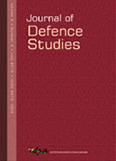Hurriyat, hawala raids are a body blow to terror funding network in Kashmir
Research Fellow, IDSA, Col Vivek Chadha’s article on the ongoing raids on the Hurriyat and its linked organisations, titled ‘Hurriyat, hawala raids are a body blow to terror funding network in Kashmir’ was published in ‘Daily O’ on June 6, 2017.
- Published: 6 June, 2017













